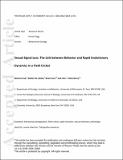Files in this item
Sexual signal loss : the link between behaviour and rapid evolutionary dynamics in a field cricket
Item metadata
| dc.contributor.author | Zuk, Marlene | |
| dc.contributor.author | Bailey, Nathan W. | |
| dc.contributor.author | Gray, Brian | |
| dc.contributor.author | Rotenberry, John T. | |
| dc.date.accessioned | 2019-03-05T00:37:12Z | |
| dc.date.available | 2019-03-05T00:37:12Z | |
| dc.date.issued | 2018-03-05 | |
| dc.identifier | 252046706 | |
| dc.identifier | f85d12e7-12ee-4f93-b9fc-3a8995549f55 | |
| dc.identifier | 85043307074 | |
| dc.identifier | 000430059900009 | |
| dc.identifier.citation | Zuk , M , Bailey , N W , Gray , B & Rotenberry , J T 2018 , ' Sexual signal loss : the link between behaviour and rapid evolutionary dynamics in a field cricket ' , Journal of Animal Ecology , vol. Early View . https://doi.org/10.1111/1365-2656.12806 | en |
| dc.identifier.issn | 0021-8790 | |
| dc.identifier.other | ORCID: /0000-0003-3531-7756/work/60888404 | |
| dc.identifier.uri | https://hdl.handle.net/10023/17209 | |
| dc.description | N.W.B. received funding from Natural Environment Research Council fellowships (NE/G014906/1 and NE/L011255/1). M.Z. is supported by grants from the US National Science Foundation and by the University of Minnesota. Data used in these analyses (counts of crickets in survey plots and distances from playback speakers) have been placed in the Dryad Digital Repository and are accessible at https://doi.org/10.5061/dryad.bb384 (Zuk et al., 2018). | en |
| dc.description.abstract | 1. Sexual signals may be acquired or lost over evolutionary time, and are tempered in their exaggeration by natural selection. 2. In the Pacific field cricket, Teleogryllus oceanicus, a mutation (“flatwing”) causing loss of the sexual signal, the song, spread in <20 generations in two of three Hawaiian islands where the crickets have been introduced. Flatwing (as well as some normal-wing) males behave as satellites, moving towards and settling near calling males to intercept phonotactic females. 3. From 2005 to 2012, we surveyed crickets and their responses to conspecific song, noting the morph and number of males and females before and after experimental playbacks. The three Hawaiian islands consistently contained different proportions of flatwing crickets, ranging from about 90% of males on Kauai to 50% on Oahu to rare on the Big Island of Hawaii. 4. Flatwing and normal-wing males do not appear to differ in responsiveness to playback, a behaviour that should influence the likelihood of a male encountering a phonotactic female. Instead, male and female crickets from populations in which little to no calling song is perceptible during development tended to seek out callers more readily than crickets that developed in noisier environments. Such increased phonotaxis makes females more likely to find either the caller to which they are responding or to encounter a flatwing (or normal male satellite) that has also been attracted to the song. 5. Our evidence suggests that pre-existing behavioural plasticity (manifest as flexible responses to social—particularly acoustic—information in the environment) is associated with the rapid spread of the flatwing trait. Different social environments select for differential success of flatwing or normal-wing males, which in turn alters the social environment itself. | |
| dc.format.extent | 1778712 | |
| dc.language.iso | eng | |
| dc.relation.ispartof | Journal of Animal Ecology | en |
| dc.subject | Behavioural preadaptation | en |
| dc.subject | Field cricket | en |
| dc.subject | Rapid evolution | en |
| dc.subject | Natural selection | en |
| dc.subject | Phenotypic plasticity | en |
| dc.subject | Sexual selection | en |
| dc.subject | Teleogryllus oceanicus | en |
| dc.subject | QH301 Biology | en |
| dc.subject | DAS | en |
| dc.subject.lcc | QH301 | en |
| dc.title | Sexual signal loss : the link between behaviour and rapid evolutionary dynamics in a field cricket | en |
| dc.type | Journal article | en |
| dc.contributor.sponsor | NERC | en |
| dc.contributor.sponsor | NERC | en |
| dc.contributor.sponsor | NERC | en |
| dc.contributor.institution | University of St Andrews. School of Biology | en |
| dc.contributor.institution | University of St Andrews. Centre for Biological Diversity | en |
| dc.identifier.doi | https://doi.org/10.1111/1365-2656.12806 | |
| dc.description.status | Peer reviewed | en |
| dc.date.embargoedUntil | 2019-03-05 | |
| dc.identifier.grantnumber | Ne/I027800/1 | en |
| dc.identifier.grantnumber | NE/G014906/1 | en |
| dc.identifier.grantnumber | NE/L011255/1 | en |
This item appears in the following Collection(s)
Items in the St Andrews Research Repository are protected by copyright, with all rights reserved, unless otherwise indicated.

